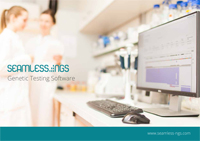Hi all. On a different note...I do not really understand how one is supposed to combine the N7 and S5 primers in the QIAseq Targeted DNA Panel. Do they have to be combined in a TruSeq-like fashion? So different N7s dispensed by rows and different S5s dispensed by columns?
Seqanswers Leaderboard Ad
Collapse
Announcement
Collapse
No announcement yet.
X
-
Hi everyone,
our genetic testing software 'Seamless NGS' offers an easy-to-use workflow for the analysis of Qiagen's QiaSeq panels.
Before mapping the reads, the common sequence and the UMIs are clipped away. After mapping, the UMIs sequences are properly used to correct for PCR clones and the single amplicon primer is clipped away to ensure correct and unbiased variant calling. The workflow was developed, tested and validated together with a trustworthy pathological laboratory at one of the oldest university hospitals in Germany. Having long-lasting experience in that field, together with them, ecSeq was able to get the most out of the QiaSeq panel.
If you are interested in our solution, please check www.seamless-ngs.com and/or write us a short email ([email protected]) to make an appointment for a personal live demo (online).
 Last edited by ecSeq Bioinformatics; 05-13-2019, 01:16 AM.ecSeq Bioinformatics is Europe’s leading provider of hands-on bioinformatics workshops and professional data analysis in the field of Next-Generation Sequencing (NGS).
Last edited by ecSeq Bioinformatics; 05-13-2019, 01:16 AM.ecSeq Bioinformatics is Europe’s leading provider of hands-on bioinformatics workshops and professional data analysis in the field of Next-Generation Sequencing (NGS).
Comment
Latest Articles
Collapse
-
by seqadmin
Proteins are often described as the workhorses of the cell, and identifying their sequences is key to understanding their role in biological processes and disease. Currently, the most common technique used to determine protein sequences is mass spectrometry. While still a valuable tool, mass spectrometry faces several limitations and requires a highly experienced scientist familiar with the equipment to operate it. Additionally, other proteomic methods, like affinity assays, are constrained...-
Channel: Articles
04-04-2024, 04:25 PM -
-
by seqadmin
Despite advancements in sequencing platforms and related sample preparation technologies, certain sample types continue to present significant challenges that can compromise sequencing results. Pedro Echave, Senior Manager of the Global Business Segment at Revvity, explained that the success of a sequencing experiment ultimately depends on the amount and integrity of the nucleic acid template (RNA or DNA) obtained from a sample. “The better the quality of the nucleic acid isolated...-
Channel: Articles
03-22-2024, 06:39 AM -
ad_right_rmr
Collapse
News
Collapse
| Topics | Statistics | Last Post | ||
|---|---|---|---|---|
|
Started by seqadmin, 04-11-2024, 12:08 PM
|
0 responses
18 views
0 likes
|
Last Post
by seqadmin
04-11-2024, 12:08 PM
|
||
|
Started by seqadmin, 04-10-2024, 10:19 PM
|
0 responses
22 views
0 likes
|
Last Post
by seqadmin
04-10-2024, 10:19 PM
|
||
|
Started by seqadmin, 04-10-2024, 09:21 AM
|
0 responses
17 views
0 likes
|
Last Post
by seqadmin
04-10-2024, 09:21 AM
|
||
|
Started by seqadmin, 04-04-2024, 09:00 AM
|
0 responses
49 views
0 likes
|
Last Post
by seqadmin
04-04-2024, 09:00 AM
|
Comment